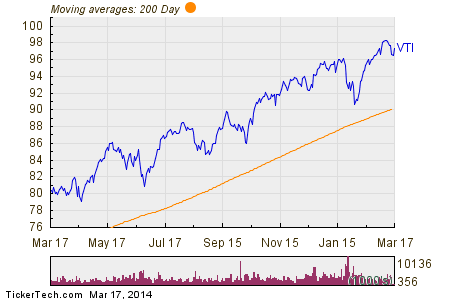Vanguard Total Stock Market ETF (VTI)
Post on: 14 Июнь, 2015 No Comment

Canadians wanting to get exposure to the US stock market through an ETF have a range of options. They could choose to invest in the well-known S&P 500 index, which is composed of 500 of the largest-capitalization stocks listed in the US. A better option is to track a total market index, which includes almost every stock listed on the US exchanges. Burton Malkiel, explains the rationale in the latest edition of A Random Walk Down Wall Street :
The S&P 500 omits the thousands of small companies that are among the most dynamic in the economy. Thus, I now believe that if an investor is to buy only one index fund, the best general U.S. index to emulate is one of the broader indexes such as the Russell 3000, the Dow-Wiltshire 5000-stock index, or the MSCI broad U.S. Index not the S&P 500.
The Vanguard Total Stock Market ETF. which trades under the ticker VTI, tracks the returns of the entire US market (the MSCI index) for a rock bottom MER of 0.07%. If you buy-and-hold this one ETF, you will capture the entire US market, including small caps, for a very modest cost.
ETFs that track the S&P 500 index, which are listed on American exchanges and hence denominated in US dollars are SPDR 500 (Ticker symbol SPY, also known as Spiders) and the iShares S&P 500 Index Fund (Ticker symbol IVV). There is little to choose between SPY and IVV: they cost almost the same to own (IVV 0.09% and SPY 0.10%) but the SPY is a lot more liquid. If you invest in either the SPY or IVV, you would obtain the returns of the S&P 500 (less modest expenses) translated into Canadian dollars.
Canadian investors also have the option of tracking the S&P 500 using the iShares CDN S&P 500 Index Fund. which is listed on the TSX with the ticker symbol XSP and denominated in Canadian dollars. XSP, simply owns the US-listed IVV, and adds a currency hedge on top of it. Of course, youll pay an extra 0.15% as a cost for the hedge for a total cost of 0.24% (0.09% for the IVV and 0.15% for the XSP). The hedging enables investors to capture the return of the S&P 500 in Canadian dollars without the gains or losses due to currency fluctuations.
My personal preference is to invest directly in US-listed ETFs without hedging currency exposure because in my opinion, hedging is simply chasing performance after the Canadian dollar has run up significantly. Recall that hardly any mutual fund or ETF engaged in hedging when the loonie was in the dumps but now it is a popular selling feature. Why pay an extra fee when currency fluctuations will even out over the long term? It is so predictable investors are always fighting the last war.
NB: I apologize getting fairly technical in yesterdays post and not doing a better job of explaining the terms. Thanks to Steve for pointing out my error. I really appreciate it.














